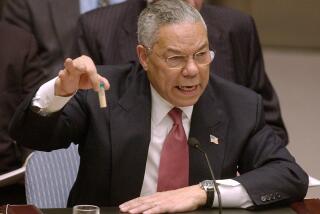Gulf Crisis Found to Be 1990’s Top Story
- Share via
WASHINGTON — The crisis in the Persian Gulf was by far the biggest news story of 1990, with more than 60% of Americans participating in monthly surveys saying they have “closely followed” developments since Iraq invaded Kuwait in early August.
According to a year-end assessment issued Friday, the only domestic development that drew similarly close attention was a direct spin-off of the gulf crisis: the rise in gasoline prices caused by the invasion’s impact on world petroleum markets.
Each month, the Times Mirror Center for The People & The Press surveys a sample of Americans to determine what news stories attracted the most attention and what the public learned from them.
In its year-end report, the center said the gulf crisis had generated unusually intense and prolonged interest among news consumers.
With one exception, the only news stories that attracted more than 40% interest in this year’s monthly surveys were those involving the U.S. military buildup in the gulf, the hostages held in Iraq and Kuwait and the steep rise in gasoline prices at home.
The single exception was the U.S. invasion of Panama, which was closely followed by 60% of those who participated in last January’s survey.
By contrast, the peaceful revolution in Eastern Europe and turmoil within the Soviet Union attracted relatively little attention. In no month were stories on these topics closely followed by 30% of those surveyed.
The intense focus on the gulf conflict appeared to divert attention from news closer to home. Besides the gasoline price rise, the top-rated domestic stories were the decline of the economy and sensational crimes.
News interest intensified as the U.S. economy began to slip in late summer, according to the surveys. By November, 39% of respondents said they were closely following economic news.
Only sensational crime stories tended to attract as much attention. The September murders of five people near the University of Florida campus registered 36% on the “closely followed” index, and 29% of survey participants said they focused on the bizarre Boston suicide and murder of Charles Stuart and his wife.
Meanwhile, there was a clear consensus on the most over-covered story of the year: the marital troubles of Donald and Ivana Trump. In March, a record 55% of those surveyed said they were fed up with news about the Trumps’ travails.
The center also tallies how many respondents can correctly identify names in the news. The results suggest that even the key figures in the most closely followed stories are not well known. Only 17% could correctly identify Gen. Colin Powell, chairman of the Joint Chiefs of Staff and the nation’s top military leader. However, 37% were able to correctly identify Marla Maples, Donald Trump’s paramour.
More to Read
Sign up for Essential California
The most important California stories and recommendations in your inbox every morning.
You may occasionally receive promotional content from the Los Angeles Times.












